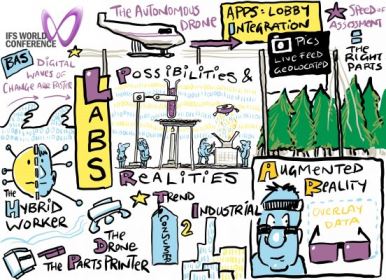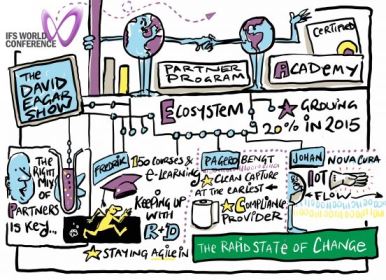Bas de Vos
Director, IFS Labs

Today, the number of scientists and engineers inventing new things is greater than the rest of history put together. Periods of innovation are followed by periods of consolidation, but those waves are getting closer and closer together. After the consolidation of going mobile, we have the innovation of cognitive computing and augmented reality (AR).
These waves mean great agility from organizations to be ready. We try to be ahead of the curve to help you with the journey. Digital transformation will fail if you only focus on the technology, but not on the way we work.
As data from your devices is streaming into IFS, it can move into predictive analytics. Workers are always connected, with location-aware devices. When working, they can use voice control and intelligent autonomous digital assistants (bots) to capture or obtain information. AR help you deliver repairs. Drones can bring you urgently 3D printed devices and the drones are covered in sensors data being fed into IFS… The circle is complete.
Beacons
Beacons were introduced in 2013 by Apple and then followed by Google in 2015 with Eddystone. They are ways of grabbing a customer’s attention via their phone. It’s being used in the consumer space – shops, museums, theme parks. Can this be brought to industrial applications?
We have the beacon locator app on show here, which allows you to just walk up to machines, and see their state on your phone. This has big implications for maintenance and reduces the need for site knowledge.
Augmented Reality
Pokémon Go brought AR to the mainstream and it’s not hard to see how it might assist people in the industrial sector. But let’s step away from hand-held devices and think about wearables. Glasses technology is accelerating – look at Microsoft’s Hololens. The next step is integrating it into tech that people must wear anyway – like safety googles.
Drones
Drones could transform your business, and the benefits will outweigh the costs soon. Yes, legislation is still an issue, especially in Sweden, but elsewhere as well. Imagine yourself in the vast woods of Sweden – it’s a sparsely populated country and getting power to rural areas normally means overhead power cables. But that means they’re exposed and vulnerable to extreme weather. When a power line goes down, you need to find the break and repair it as soon as possible. You could do that with a helicopter – which is expensive – or you could do it much faster with a single drone or a fleet of them.
IFS Labs has built a drone lobby in IFS Applications. This can be used to control the drone and capture images and relevant sensor data into IFS Applications. You can display the data on a map and start connecting it with customer calls and raise work orders.
With non-expensive helicopters or inefficient manual exploration, you can repairs things quickly. This tech has applications in logistics, facilities management and many other fields.
The David Eagar Show

A quick poll of the room shows that over two-thirds of the attendees think it’s very important that a supplier is an IFS Partner. That’s good news! We’ve been working hard on that.
We launched the IFS Partner Network in Boston. That allowed us to identify specific types of partners. But we also wanted to offer a tier structure. We think it’s important that customers understand the level of effort put into becoming familiar with our systems. The four tier – bronze/silver/gold/platinum – structure applies by area of specialty, so a partner can be Gold in software and Silver in Channel, for example. We added the IFS Academy to help with this.
We’re continuing to grow our partner ecosystem. The question is: what’s next?
Well, we’re going to work on right-sizing partners. More is not always better. Do we have the right mix of partner types? Do we have them in the right regions? Do we have enough large, global partners as well as the local ones? At the same time, we want to increase our support for partners in all their areas where they partner with us.
This message was well covered by partners at our partner summit at the beginning of the week. We also announced our inaugural Partners of the Year Awards.
IFS Academy
We’re now operating a huge range of training packages and we’re seeing a surge in partners getting certification. We have both classroom training and eLearning, over a range of subjects, including software development. eLearning is very popular – we’ll be focusing on that as it’s very cost efficient.
Bengt Nilsson, Pagero
A plane crash survivor. An elevator crash survivor. A Formula 3 crash survivor.
There are increasing demands to digitalize all of our services. We talk about drones – but how about orders and invoices? Do that, and there will be plenty of time and money for drones afterward. We tend to focus on processes but what about the data itself? We’re a paper-free company – if you want money from us, send a digital invoice. We talk about legislation and compliance but it’s all about taxes and VAT.
Johan Melander, Novacura
I thought that the internet of things (IoT) was just an American buzzword until I bumped into a neighbor in the same building who made socks and gloves for skiers are heated – and which you can control from your phone. Soon, we’ll have machines ordering their own spare parts from a local 3D printing shop – that has huge implications for logistics, warehousing and so on. There’s two modes of IT investment – mode one, which is maintaining and developing systems for what you do now, and mode two where you invest in innovation and new approaches. In 2010, 90% of corporate spending was spent on mode one. That has to change and that’s where we come in – we can help with that.